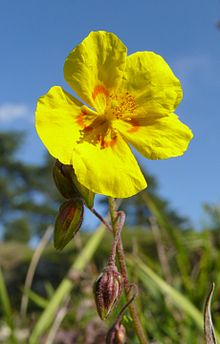Helianthemum

Helianthemum /ˌhiːliˈænθɪməm/,[1] known as rock rose, sunrose, rushrose, or frostweed,[2] is a genus of about 110[3] species of flowering plants in the family Cistaceae. They are widely distributed throughout the Northern Hemisphere, especially in the Mediterranean.[3]
New World species formerly classified as Helianthemum have been transferred to genus Crocanthemum.[4][5]
These are usually shrubs or subshrubs, and some are herbaceous annuals or perennials. The leaves are oppositely arranged, but some plants may have alternately arranged leaves along the upper stems. The flowers are solitary or borne in an array of inflorescence types, such as panicles, racemes, or headlike clusters. The flower has three inner sepals and two smaller outer sepals. It has five petals usually in shades of yellow, orange, or pink. The style at the center is tipped with a large stigma. The fruit is a capsule containing many seeds.[3]
Helianthemum are known to form symbioses with mycorrhizal fungi. In the Mediterranean they are associated with Terfeziaceae, the desert truffles. Together, plant and fungus may have a beneficial effect on the arid local landscapes, preventing soil erosion and desertification. Some symbiotic pairs include Helianthemum salicifolium and the truffle Tirmania nivea, and H. guttatum and T. pinoyi.[6]
